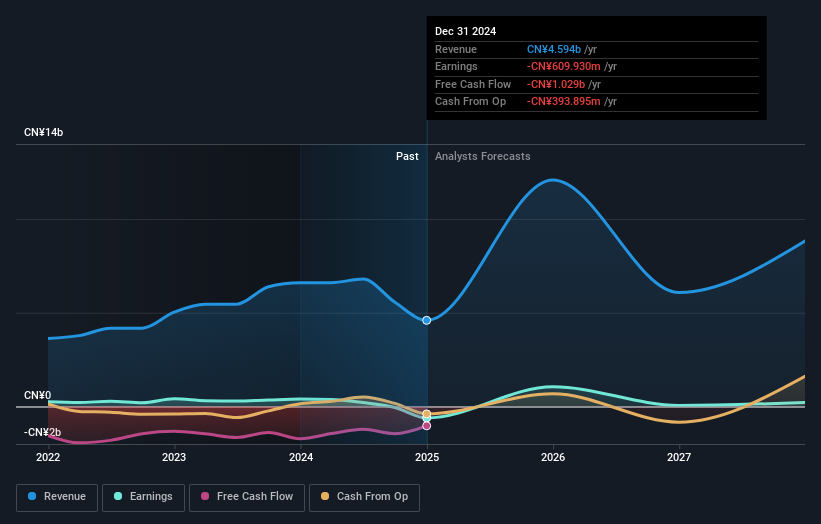
There's been a notable change in appetite for Triumph New Energy Company Limited (HKG:1108) shares in the week since its full-year report, with the stock down 18% to HK$3.81. It was a pretty negative result overall, with revenues of CN¥4.6b missing analyst predictions by 8.2%. Worse, the business reported a statutory loss of CN¥0.94 per share, a substantial decline on analyst expectations of a profit. This is an important time for investors, as they can track a company's performance in its report, look at what experts are forecasting for next year, and see if there has been any change to expectations for the business. So we gathered the latest post-earnings forecasts to see what estimates suggest is in store for next year.

Taking into account the latest results, the current consensus from Triumph New Energy's two analysts is for revenues of CN¥12.1b in 2025. This would reflect a sizeable 163% increase on its revenue over the past 12 months. Earnings are expected to improve, with Triumph New Energy forecast to report a statutory profit of CN¥1.54 per share. Before this earnings report, the analysts had been forecasting revenues of CN¥9.03b and earnings per share (EPS) of CN¥0.82 in 2025. There has definitely been an improvement in perception after these results, with the analysts noticeably increasing both their earnings and revenue estimates.
Check out our latest analysis for Triumph New Energy
As a result, it might be a surprise to see thatthe analysts have cut their price target 9.5% to HK$5.97, which could suggest the forecast improvement in performance is not expected to last.
Of course, another way to look at these forecasts is to place them into context against the industry itself. It's clear from the latest estimates that Triumph New Energy's rate of growth is expected to accelerate meaningfully, with the forecast 163% annualised revenue growth to the end of 2025 noticeably faster than its historical growth of 20% p.a. over the past five years. Compare this with other companies in the same industry, which are forecast to grow their revenue 7.5% annually. It seems obvious that, while the growth outlook is brighter than the recent past, the analysts also expect Triumph New Energy to grow faster than the wider industry.
The Bottom Line
The biggest takeaway for us is the consensus earnings per share upgrade, which suggests a clear improvement in sentiment around Triumph New Energy's earnings potential next year. Pleasantly, they also upgraded their revenue estimates, and their forecasts suggest the business is expected to grow faster than the wider industry. The consensus price target fell measurably, with the analysts seemingly not reassured by the latest results, leading to a lower estimate of Triumph New Energy's future valuation.
With that said, the long-term trajectory of the company's earnings is a lot more important than next year. We have analyst estimates for Triumph New Energy going out as far as 2027, and you can see them free on our platform here.
That said, it's still necessary to consider the ever-present spectre of investment risk. We've identified 1 warning sign with Triumph New Energy , and understanding it should be part of your investment process.
Have feedback on this article? Concerned about the content? Get in touch with us directly. Alternatively, email editorial-team (at) simplywallst.com.
This article by Simply Wall St is general in nature. We provide commentary based on historical data and analyst forecasts only using an unbiased methodology and our articles are not intended to be financial advice. It does not constitute a recommendation to buy or sell any stock, and does not take account of your objectives, or your financial situation. We aim to bring you long-term focused analysis driven by fundamental data. Note that our analysis may not factor in the latest price-sensitive company announcements or qualitative material. Simply Wall St has no position in any stocks mentioned.